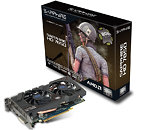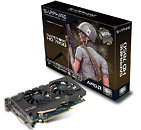Monday, July 16th 2012

SAPPHIRE Updates HD 7850 Family
The first two new versions of the HD 7850 being introduced by SAPPHIRE have 2GB of the latest DDR5 memory. The standard model will ship with a core clock speed of 860MHz, and. memory clocked at 1200MHz (4.8Gb/s effective). At the same time SAPPHIRE is introducing a higher performance model, the SAPPHIRE HD 7850 OC Edition, with the faster clocks of 920MHz core and 1250MHz (5Gb/s effective) for the memory. Offering excellent performance at an even keener price point, the third model in the series is the SAPPHIRE HD 7850 1GB model which will ship with the core clock of 900MHz and memory at 1200MHz (4.8Gb/s effective).
All three models are equipped with a dual BIOS, and the new output configuration of Dual link DVI-I, Dual link DVI-D, HDMI and Display Port. They also feature SAPPHIRE's latest dual-extractor cooler technology - Dual-X - a highly efficient multi-heatpipe cooler with dual fans providing quiet and very cool operation during normal operating conditions, and superb cooling performance even under extreme load.For enthusiasts wishing to maximise performance, a new version of the SAPPHIRE overclocking tool, TriXX, supporting this latest generation of technology is available free to download from the SAPPHIRE website. TriXX allows tuning of GPU voltage as well as core and memory clocks, whilst continuously displaying temperature. Manual control of fan speed is supported, as well as user created fan profiles and the ability to save up to four different performance settings.
Working or gaming with multiple monitors is becoming increasingly popular, and the SAPPHIRE HD 7800 series supports this with AMD Eyefinity, now in its second generation. In multi-monitor setups, SAPPHIRE HD 7800 series cards can simultaneously output multiple, independent audio streams allowing the correct audio content to be associated with different applications on different screens.
HDMI specifications have also increased in the HD 7000 series. Fast HDMI 1.4a supports Stereoscopic 3D with enhanced frame rates of 60Hz per eye - 120Hz total. It is also ready for the next generation of 4K displays that can be driven from a single high speed input of 3GHz HDMI 1.4a or DisplayPort 1.2 HBR2.
APP Acceleration is the name given to the enhanced performance of a wide range of applications using the stream processing capabilities and specific hardware features of the graphics architecture. The HD 7000 series has been optimised for this type of task. Typical applications include Video encoding and decoding, compression and multiplexing for media distribution, gaming or video conferencing. APP acceleration can also enhance everyday tasks such as Internet browsing, Office applications and file compression with supported software suites.
The new SAPPHIRE HD 7850 series products will be available through SAPPHIRE's established channel and etail partners.
All three models are equipped with a dual BIOS, and the new output configuration of Dual link DVI-I, Dual link DVI-D, HDMI and Display Port. They also feature SAPPHIRE's latest dual-extractor cooler technology - Dual-X - a highly efficient multi-heatpipe cooler with dual fans providing quiet and very cool operation during normal operating conditions, and superb cooling performance even under extreme load.For enthusiasts wishing to maximise performance, a new version of the SAPPHIRE overclocking tool, TriXX, supporting this latest generation of technology is available free to download from the SAPPHIRE website. TriXX allows tuning of GPU voltage as well as core and memory clocks, whilst continuously displaying temperature. Manual control of fan speed is supported, as well as user created fan profiles and the ability to save up to four different performance settings.
Working or gaming with multiple monitors is becoming increasingly popular, and the SAPPHIRE HD 7800 series supports this with AMD Eyefinity, now in its second generation. In multi-monitor setups, SAPPHIRE HD 7800 series cards can simultaneously output multiple, independent audio streams allowing the correct audio content to be associated with different applications on different screens.
HDMI specifications have also increased in the HD 7000 series. Fast HDMI 1.4a supports Stereoscopic 3D with enhanced frame rates of 60Hz per eye - 120Hz total. It is also ready for the next generation of 4K displays that can be driven from a single high speed input of 3GHz HDMI 1.4a or DisplayPort 1.2 HBR2.
APP Acceleration is the name given to the enhanced performance of a wide range of applications using the stream processing capabilities and specific hardware features of the graphics architecture. The HD 7000 series has been optimised for this type of task. Typical applications include Video encoding and decoding, compression and multiplexing for media distribution, gaming or video conferencing. APP acceleration can also enhance everyday tasks such as Internet browsing, Office applications and file compression with supported software suites.
The new SAPPHIRE HD 7850 series products will be available through SAPPHIRE's established channel and etail partners.


8 Comments on SAPPHIRE Updates HD 7850 Family
So does this mean we could flash a single BIOS and select it? This could be great for overclocking.
The especially awesome thing is that the 7850 is a demon overclocker most of the time. I had two Asus 7850s that both easily went up to 1150MHz, one with only very minimal voltage bump. Basically, you can pretty well confidently assume that your 7850 will go to the AMD CCC software overdrive limit of 1050MHz on stock volts, and almost guaranteed break 1100MHz either without a voltage bump, or with only a very minimal bump. This I can say after having had two 7850s and reading countless 7850 results on various overclocking forums. If I were on a stricter budget, I'd spring for one of these Sapphires and flash the bios with the Gigabyte Windforce 7870 bios, which would give you a native 1100MHz core speed without having to run overclocking software! (There's just a certain 'je ne sais quoi' to booting your computer without Sapphire Trix or MSI Afterburner or Asus GPU Tweak, to open up GPU-Z, and see the clock speed of your normally 860MHz GPU say 1100MHz! It will put a permanent smile on your face!)
Now all we need is support for the 7000-series Radeons in a tool like WinFlash so we can find our best overclocks using software, and then flash customized versions of the bios. Right now, you can flash other versions of the bios onto your card, but only ones from existing products. My Gigabyte Windforce 7950, for example, is currently using the Gigabyte Windforce 7970 bios (1000MHz core, 1375MHz memory - bumped up to 1050MHz with CCC slider).
I have tried several other of other bioses from the techpowerup 7970 database (most work fine, some don't, but you can always re-flash by starting up with the other bios and switching over just before you flash) but I'd really just like to mod the Gigabyte Windforce bios itself. I'd even pay a few bucks for the software. Hope somebody is reading this!
PS : i have red reviews on this CLUB 3D royal queen HD 7850 1 GB which is SAME as SAPPHIRE HD 7850 1 GB .. and CLUB 3D was not giving any performance penalty at FULL HD , do u think the SAPPHIRE will keep up like it or will i find any performance penalty?
THANKS A LOT FOR YOUR REPLY and TIME.
You will not be able to play at 1920x1080 at the full speed of the card with a 1Gb card, no matter whether it's AMD or Nvidia, in a number of games. Obviously, in older games, this will not be an issue, but newer games with larger textures (HD texture packs), will usually run out of texture memory on a 1Gb card at 1920x1080. In some cases, even if you lower some of the settings. The game will still run, but you'll be taking a significant performance hit if you run out of texture memory. Here's an example with SkyRim:
www.anandtech.com/show/6359/the-nvidia-geforce-gtx-650-ti-review/15
In my view, it's not worth it to buy a 1Gb video card anymore, period. Basically, the 2Gb version of the 7850 is the best bang for the buck card out there right now. And as I mentioned, although I'm partial to the Asus Direct CU II cooler (incredibly quiet/cool), I'd go for the SAPPHIRE HD 7850 OC simply because it also has a decent cooler, but it also has a dual bios switch. However, if you really know what you're doing, and you know how to recover a video card from a bad bios flash using a 2nd, old PCI video card, you can also go with any 2Gb 7850 card, and try to flash it with one of these bioses from the TechPowerUp! database:
www.techpowerup.com/vgabios/index.php?page=1&architecture=&manufacturer=&model=HD+7850&interface=&memSize=0
The Asus one is currently the fastest of the bunch, with a 1050MHz core and 1250MHz memory speed. In my experience, just about any 7850 will run at these speeds on default voltage. The only issue would be compatibility; some manufacturer's bioses just don't work for some reason on some other manufacturer's cards, even if the core/memory speeds should be fine. It's all trial and error, hence my preference for the dual bios.
Good luck, and let us all know what you get, and what your bios flashing results are.
Thanks a lot for the information , i really appreciate it and it helps a lot. but i have ordered for the SAPPHIRE HD 7850 1 GB Dual X Overclocked edition and there is a few reasons behind it. I have made a lots of research regarding the Vram thing and these are the facts i gathered. first thing is that as per the review 1 GB Vram is pretty much enough to handle any game at 1920x1080p EXCEPT for high resolution texture packs. I really dont care much of the high resolution texture pack to be honest with you. More than that , i dont own a monitor with screen resolution to full HD. for my Monitor an HD 7850 1 GB OC edition is an OVERKILL and i dont have any plans to upgrade my Monitor for upcoming 2 years. The best thing is that HD 7850 is an awesome card for now and even 1 GB is a future proof for gaming at 1080p but with rest of the settings like AA or Ubersampling to low or medium for atleast coming 1.5 to 2 years is what i believe. I might be wrong , if i am then please correct me , i love to learn.
Different people got different likes and dislikes , for me a screen size of 19inch and resolution of 1336x768 is enough , i mean i find it really good when all maxed out .. i am not a fan of high resolution screens.
do you agree with my thoughts about this ? please let me know and please correct me wherever possible.
really thanks a lot.
pd: sorry for my English :)
pd: sorry for my English :)